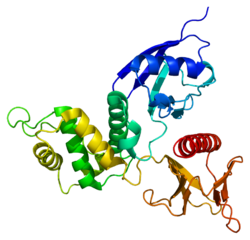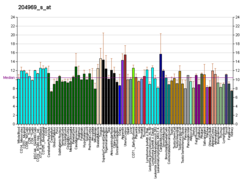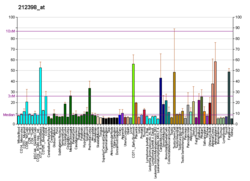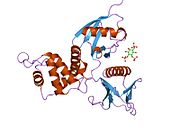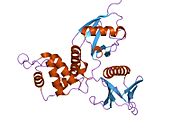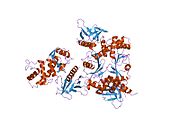
ADP-ribosylation factor 6 (ARF6) is a member of the ADP ribosylation factor family of GTP-binding proteins. ARF6 has a variety of cellular functions that are frequently involved in trafficking of biological membranes and transmembrane protein cargo. ARF6 has specifically been implicated in endocytosis of plasma membrane proteins and also, to a lesser extent, plasma membrane protein recycling.

Merlin is a cytoskeletal protein. In humans, it is a tumor suppressor protein involved in neurofibromatosis type II. Sequence data reveal its similarity to the ERM protein family.

Leukosialin also known as sialophorin or CD43 is a transmembrane cell surface protein that in humans is encoded by the SPN (sialophorin) gene.

Ezrin also known as cytovillin or villin-2 is a protein that in humans is encoded by the EZR gene.

Zonula occludens-1 ZO-1, also known as Tight junction protein-1 is a 220-kD peripheral membrane protein that is encoded by the TJP1 gene in humans. It belongs to the family of zonula occludens proteins, which are tight junction-associated proteins and of which, ZO-1 is the first to be cloned. It was first isolated in 1986 by Stevenson and Goodenough using a monoclonal antibody raised in rodent liver to recognise a 225-kD polypeptide in whole liver homogenates and in tight junction-enriched membrane fractions. It has a role as a scaffold protein which cross-links and anchors Tight Junction (TJ) strand proteins, which are fibril-like structures within the lipid bilayer, to the actin cytoskeleton.

Sodium-hydrogen antiporter 3 regulator 1 is a regulator of Sodium-hydrogen antiporter 3. It is encoded by the gene SLC9A3R1. It is also known as ERM Binding Protein 50 (EBP50) or Na+/H+ Exchanger Regulatory Factor (NHERF1). It is believed to interact via long-range allostery, involving significant protein dynamics.

Claudin-1 is a protein that in humans is encoded by the CLDN1 gene. It belongs to the group of claudins.

Intercellular adhesion molecule 2 (ICAM2), also known as CD102, is a human gene, and the protein resulting from it.

Sodium-hydrogen exchange regulatory cofactor NHE-RF2 (NHERF-2) also known as tyrosine kinase activator protein 1 (TKA-1) or SRY-interacting protein 1 (SIP-1) is a protein that in humans is encoded by the SLC9A3R2 gene.

Guanine nucleotide-binding protein G(q) subunit alpha is a protein that in humans is encoded by the GNAQ gene. Together with GNA11, it functions as a Gq alpha subunit.

Moesin is a protein that in humans is encoded by the MSN gene.

Claudin 3, also known as CLDN3, is a protein which in humans is encoded by the CLDN3 gene. It is a member of the claudin protein family.

Rho GDP-dissociation inhibitor 1 is a protein that in humans is encoded by the ARHGDIA gene.

Protein ECT2 is a protein that in humans is encoded by the ECT2 gene.

Phosphatidylinositol-4-phosphate 5-kinase type-1 gamma is an enzyme that in humans is encoded by the PIP5K1C gene.

Peroxisome assembly protein 12 is a protein that in humans is encoded by the PEX12 gene.

Prostaglandin F2 receptor negative regulator is a protein that in humans is encoded by the PTGFRN gene. PTGFRN has also been designated as CD315.

Immunoglobulin superfamily member 8 is a protein that in humans is encoded by the IGSF8 gene. IGSF8 has also been designated as CD316.

Myosin regulatory light chain interacting protein, also known as MYLIP, is a protein that in humans is encoded by the MYLIP gene.

The ERM protein family consists of three closely related proteins, ezrin, radixin and moesin. The three paralogs, ezrin, radixin and moesin, are present in vertebrates, whereas other species have only one ERM gene. Therefore, in vertebrates these paralogs likely arose by gene duplication.
